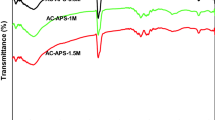Abstract
The effect of hydrophobicity on the adsorption of aromatics on metal-free activated carbons was studied. Adsorption isotherms for phenol, aniline, benzene, and xylene were generated in cyclohexane and heptane media, using seven carbons with different surface heterogeneity. The hydrophobicity of these carbons was probed using flow microcalorimetry (FMC). Surface polarity and solvent and adsorbate hydrophobicity were found to influence the adsorption capacity. For adsorbates that do not form hydrogen bonds with oxygen on the carbon surface, higher surface acidity lowers adsorption capacity due to increased polarity. In contrast, for adsorbates that can form hydrogen bonds with surface oxygen, the capacity is enhanced at higher surface acidities. A higher solvent hydrophobicity was found to decrease capacity for all the aromatic adsorbates studied, except at high surface polarity, where the effect of the solvent was found to be minimal.
Similar content being viewed by others
References
Arafat, H., M. Franz, and N. Pinto, "Effect of Salt on the Mechanism of Adsorption of Aromatics on Activated Carbon," Langmuir, 15(18), 5997–6003 (1999).
Arafat, H., F. Ahnert, and G. Pinto, "Additional Evidence for Hydrogen Bonding of Aromatics on Oxygenated Activated Carbon," Sep. Sci. & Tech., in press (2003).
Boehm, H., "Chemical Identification of Surface Groups," Adv. Catal., 16, 179 (1966).
Boehm, H., "Some Aspects of the Surface-Chemistry of Carbon-Blacks and Other Carbons," Carbon, 32(5), 759–769 (1994).
Coughlin, R. and F. Ezra, "Role of Surface Acidity in the Adsorption of Organic Pollutants on the Surface of Carbon," Environ. Sci. Technol., 2(4), 292–297 (1968).
CRC, Handbook of Chemistry and Physics, 71st ed., pp. 16–25, CRC Press, 1991.
Franz, M., H. Arafat, and N. Pinto, "Effect of Chemical Surface Heterogeneity on the Adsorption Mechanism of Dissolved Aromatics on Activated Carbon," Carbon, 38(13), 1807–1819 (2000).
Groszek, A. and S. Partyka, "Measurements of Hydrophobic and Hydrophilic Surface Sites by Flow Microcalorimetry," Langmuir, 9, 2721 (1993).
Groszek, A., "Irreversible and Reversible Adsorption of Some Heavy Transition Metals on Graphitic Carbons from Dilute Aqueous Solutions," Carbon, 35, 1329–1405 (1997).
Leng, C.C., "Mechanisms of Adsorption and Desorption of Oxygen and Nitrogen Containing Aromatics on Activated Carbon," Ph.D. Dissertation, University of Cincinnati, Cincinnati, OH, 1996.
Leon y Leon, C. and L. Radovic, in Chemistry and Physics of Carbon, P. Thrower (Ed.), vol. 24, Mercel Dekker, New York, 1994.
Leon y Leon, C., J. Solar, V. Calemma, and L. Radovic, "Evidence for the Protonation of Basal-Plane Sites on Carbon," Carbon, 30(5), 797–811 (1992).
Mattson, J., H. Mark, M. Malbin, W. Weber, and J. Critten, "Surface Chemistry of Active Carbon: Specific Adsorption of Phenol," J. Col. Interface Sci., 3(1), 116–130 (1969).
Menendez, J., D. Suarez, E. Fuente, and M. Montes-Maron, "Contribution of Pyrone-Type Structures to Carbon Basicity: Theoretical Evaluation pf the pKa of Model Compounds," Carbon, 37(6), 1002–1006 (1999).
Nevskaia, D., A. Santianes, V. Munoz, and A. Guerrero-Ruiz, "Interaction of Aqueous Solutions of Phenol with Commercial Activated Carbons: An Adsorption and Kinetic Study," Carbon, 37(7), 1065–1074 (1999).
Puri, B., in Chemistry and Physics of Carbon, P. Walker (Ed.), vol. 6, Mercel Dekker, New York, 1970.
Radovic, L., C. Moreno-Castilla, and J. Rivera-Utrilla, "Carbon Materials as Adsorbents in Aqueous Solutions," in Chemistry and Physics of Carbon, L. Radovic (Ed.), vol. 27, Mercel Dekker, New York, 2001.
Xie, F., J. Phillips, I. Silva, M. Palma, and A. Menendez, "Microcalorimetric Study of Acid Sites on Ammonia-and Acid-Pretreated Activated Carbon," Carbon, 38(5), 691–700 (2000).
Author information
Authors and Affiliations
Corresponding author
Rights and permissions
About this article
Cite this article
Ahnert, F., Arafat, H.A. & Pinto, N.G. A Study of the Influence of Hydrophobicity of Activated Carbon on the Adsorption Equilibrium of Aromatics in Non-Aqueous Media. Adsorption 9, 311–319 (2003). https://doi.org/10.1023/A:1026271830072
Issue Date:
DOI: https://doi.org/10.1023/A:1026271830072




